Global Buckling Experiments of Cold-rolled Aluminium Alloy Downturn Lip Channel Beams
Ngoc Hieu Pham1,2*
1Lecturer, Faculty of Civil Engineering, Hanoi Architectural University, Hanoi, Vietnam
1Doctoral Graduate, School of Civil Engineering, The University of Sydney, Australia
Submission: September 04, 2022; Published: January 17, 2023
*Corresponding Author: Ngoc Hieu Pham, Lecturer, Faculty of Civil Engineering, Hanoi Architectural University, Hanoi, Vietnam, Doctoral Graduate, School of Civil Engineering, The University of Sydney, Australia
How to cite this article:Pham NH. Global Buckling Experiments of Cold-rolled Aluminium Alloy Downturn Lip Channel Beams. Civil Eng Res J. 2023; 13(4): 555866. DOI 10.19080/CERJ.2023.13.555866
Abstract
The paper is aimed to describe an experimental program of cold-rolled aluminium alloy downturn lip channel beams undergoing global buckling. Cold-rolled aluminium sections can be seen as new products of BlueScope Permalite, and the downturn lip channel section is in the form of the channel section with a modification of the bottom lip direction. A series of four tests with two lengths were carried out at The University of Sydney. The experiments were driven by a dual-actuator loading system to ensure the applied load was in the upward direction through the shear centre of the investigated section specimens while testing. Global buckling failures were seen in all specimen tests. The obtained test results will be the base for the calibration of a finite element model and the proposal of new design guidelines for these section beams subjected to global buckling modes in further studies.
Keywords: Global buckling Experiments; Cold-rolled aluminium alloy; Downturn lip channel beams
Introduction
The application of aluminium alloys in structural buildings has become popular due to the innovation of their material properties [1]. In terms of manufacturing, extrusion has become popular in the world to produce aluminium alloy sections, whereas the cold-forming can be seen as a new method applied by BlueScope Permalite to successfully cold-forming channel and Zee sections. The latter method has been illustrated to be faster and more cost-effective than the former method. The channel section is the common shape and has been widely applied in structures for decades [2]. The downturn lip channel section in this paper basically in the form of the channel section has been made by changing the downturn of the bottom lip (Figure 1), this is more beneficial in the application [3]. That was the reason why the experimental program in this section was developed to study their strengths and behaviors. This test program belonged to the Australian Research Council Linkage Research Project LP140100863 between The University of Sydney and BlueScope Permalite to study the cold-rolled aluminium alloy sections.
A large number of studies on aluminium alloy sections have been available in the literature. Studies on extruded rectangular or square hollow aluminium alloy beams were conducted by many researchers [4-6]. For cold-rolled sections, experimental studies on channel and Zee section beams were fully reported in the work of Pham [7], whereas experiments on downturn lip channel sections under bending were not reported. This paper, therefore, presents the experimental program on cold-rolled aluminium alloy downturn lip channel beams in the four-point bending configuration. Global buckling failures were observed in all tests. The test results will be used for the development of design guidelines in further studies.
Specimen Dimensions and Material Properties
The cross-section for the investigation was taken from the catalogue provided by the manufacturer [3]. The selected section was based on the determination of sectional slenderness using the bucking analysis software program THIN-WALL-2 [8], as fully reported in Pham [7]. Section C25025DL was chosen for this experimental program with the intermediate sectional slenderness. The dimensions of this section are given in Table 1 and illustrated in Fig. 1. The specimen lengths were 3.0 m and 4.0 for the specimens, as given in Table 2. A specimen C25025DL-3.0m-1 is illustrated as follows:
i. “C” stands for the channel section; “DL” is for the downturn lip; number “250” indicates the sectional depth of 250 mm; “25” is the sectional thickness of 2.5 mm;
ii. “3.0m” means the specimen length of 3 meters; “1” illustrates the test number 1.
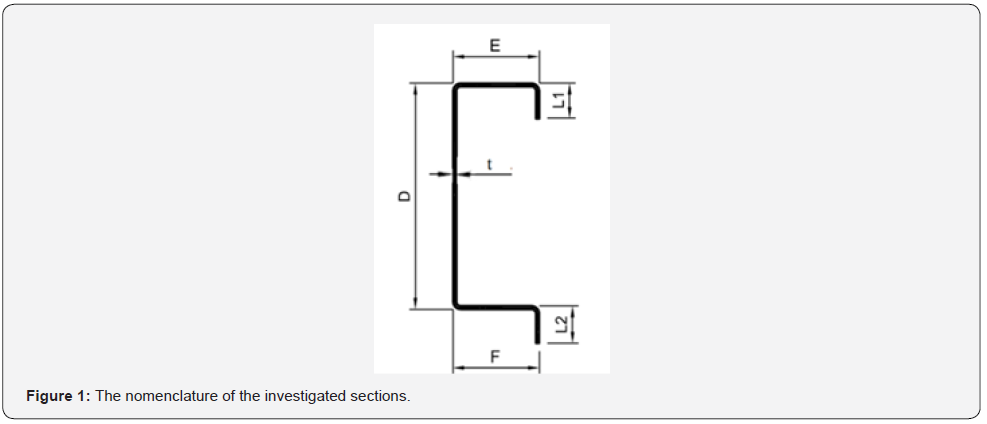
The material properties of these investigated beams were determined on the basis of the results of coupon tests, as reported in Pham [7]. The flat and corner coupon tests were carried out, as summarized in Table 3, where σ0.2 is the 0.2% proof strength; σu is the ultimate tensile strength; E0 is the Young’s modulus; εf is the uniform elongation corresponding to the total elongation after fracture; and “n” is the Ramberg-Osgood index. Prior to testing, geometric imperfections of each specimen were measured with the support of the laser scanning system, as described in Pham et al [9] and illustrated in Figure 2. The laser devices moved along the specimen lengths to measure the distance to the surfaces of the specimens through nine points as shown in Figure 2. Points (3), (4), (6), and (7) were used to measure global imperfections whereas the point (5) was for the local imperfection, and the rest points were utilized to measure distortional imperfections.
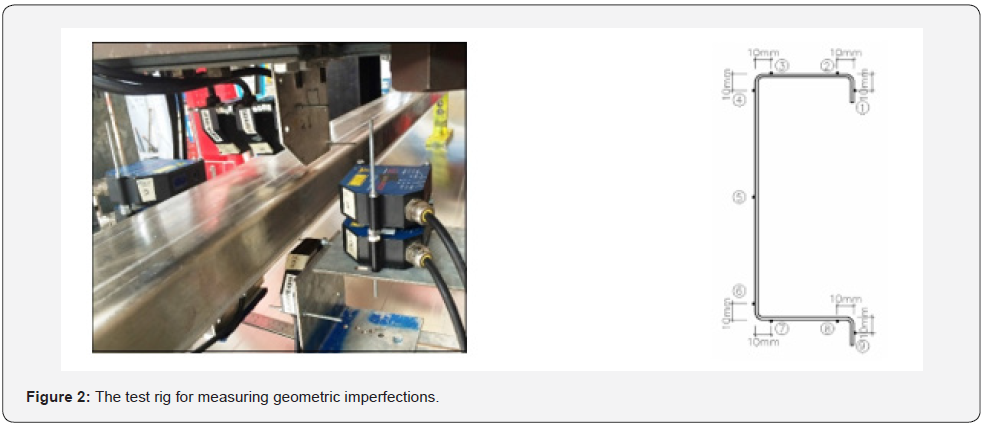
Test Set-up
In this experimental program, the test rig was in the form of a four-point bending configuration. The test rig was originally designed by Niu and Rasmussen [10] for channel sections with the mechanism presented in Pham [7]. The test set-up for downturn lip channel section beams was demonstrated in Figure 3. The applied load was driven by a dual actuator system to make sure this load was through the shear centre during testing. At two supports, restraint boxes including two perpendicular shafts helped the specimen to rotate freely about both horizontal and vertical axes, as demonstrated in Figure 4. Transducers were used to attach at two ends, applied load points and mid-span of the specimens to capture their displacements as shown in Figure 3. The inclinometers were attached to the web at the loading points to measure the specimen twist while testing as shown in Figure 5. The obtained displacements were subsequently used to analyse the specimen behaviors.




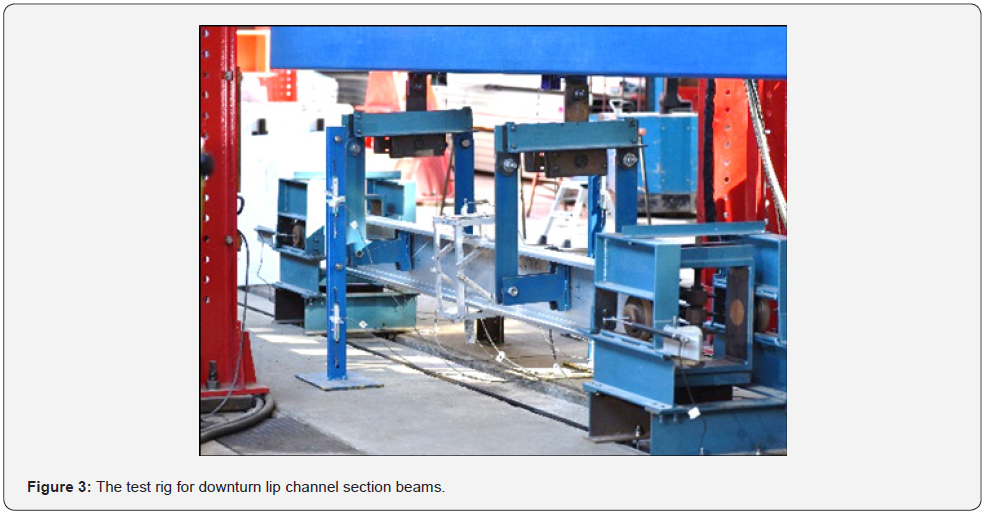
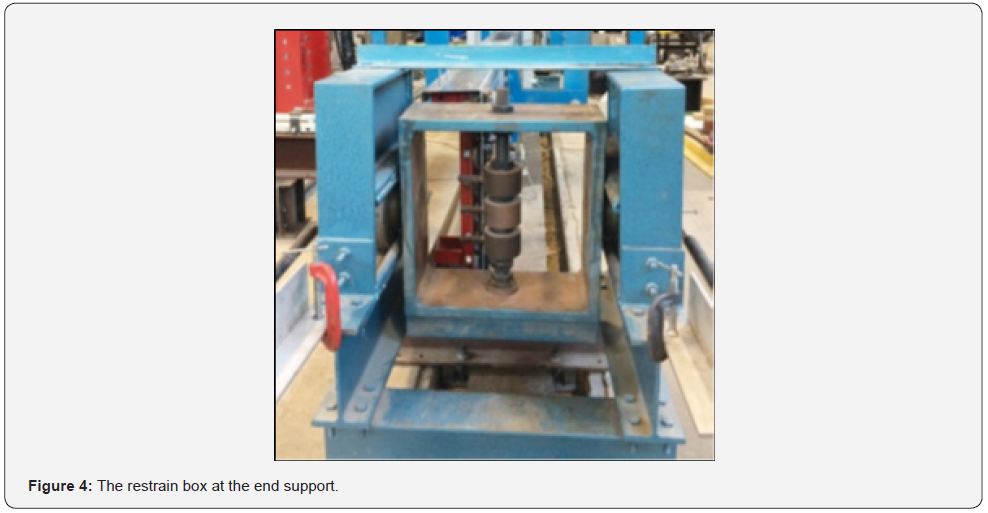

Test Results and Behaviors
Global buckling failures were seen in all specimen tests without any local or distortional deformation prior to reaching the peak loads. The global buckling failures were presented in Figure 6. The ultimate strengths of the investigated specimens are listed in Table 4. The specimens were rotated in two different directions consisting of the negative direction (anti-clockwise) and the positive direction (clockwise), as seen in Figure 6. The strengths were found to be higher for the positive failure direction, as discussed and explained in Pham [7]. The comparison between two failure directions was illustrated in Figure 7 to demonstrate the effects of twist directions on the strengths of the specimens.
Conclusion
The paper presented a test program to study the behaviors and ultimate strengths of cold-rolled aluminium alloy downturn lip channel beams undergoing global buckling failures. Test set-up was carefully designed to allow the applied loads always through the shear centre of the specimens while testing. Global buckling failures were observed in all tests with two obtained direction failures. The failure directions led to the different behaviors and strengths of the investigated specimens. The experimental results will be the base for the proposal of new design guidelines for coldrolled aluminium alloy beams. This research is ongoing at The University of Sydney.

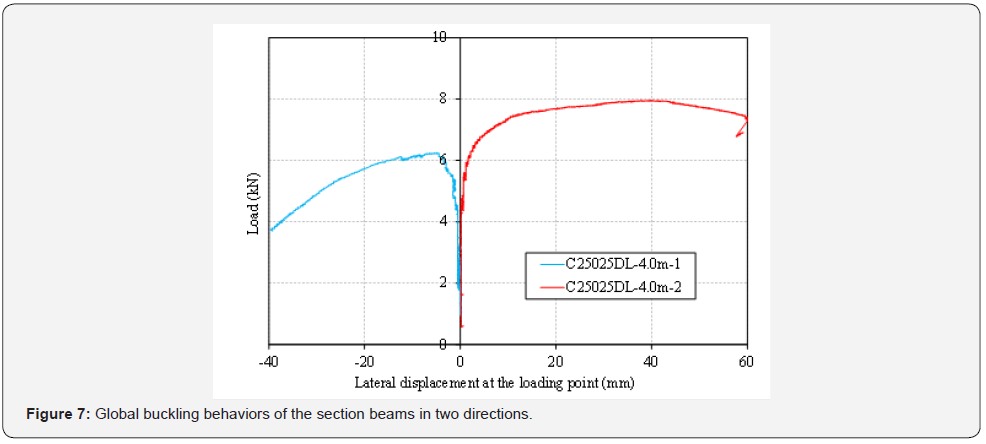
Acknowledgement
Funding provided by the Australian Research Council Linkage Research Grant LP140100563 between BlueScope Lysaght and the University of Sydney has been used to perform this research. The author would like to thank Permalite Aluminum Building Solutions Pty Ltd for the supply of the test specimens and financial support for the project.
References
- Szumigala M, Polus L (2015) Application of Aluminium and Concrete Composite Structures. Precedia Engineering 108(61): 544-549.
- Hancock GJ, Pham CH (2016) New section shapes using high-strength steels in cold-formed steel structures in Australia.
- (2015) Blue Scope Lysaghts: Permalite - Aluminium Roll-formed Purlin Solutions. Permalite Aluminium Building Solutions Pty Ltd, Eagle Farm Qld 4009, Australia.
- Su MN, Young B, Gardner L (2014) Deformation-based design of aluminium alloy beams. Engineering Structures 80: 339-349.
- Zhu JH, Young B (2009) Design of Aluminum Alloy Flexural Members Using Direct Strength Method. Journal of Structural Engineering 135(5): 558-566.
- Faella C, Mazzolani FM, Piluso V, Rizzano G (2000) Local buckling of Aluminium members: testing and classification. Journal of Structural Engineering 126(3).
- Pham NH (2019) Strength and Behaviour of Cold-rolled Aluminium Members. PhD thesis, The University of Sydney, Australia.
- Nguyen VV, Hancock GJ, Pham CH (2015) Development of the Thin-Wall-2 for Buckling Analysis of Thin-Walled Sections Under Generalised Loading. In: Proceeding of 8th International Conference on Advances in Steel Structures.
- Pham NH, Pham CH, Rasmussen KJR (2017) Incorporation of measured geometric imperfections into finite element models for cold-rolled aluminium sections. In: 4th Congres International de Geotechnique - Ouvrages - Structures, Ho Chi Minh city, Vietnam, pp. 161-171.
- Niu S (2014) Interaction buckling of cold-formed stainless steel beams. PhD thesis, the University of Sydney, Australia.






























